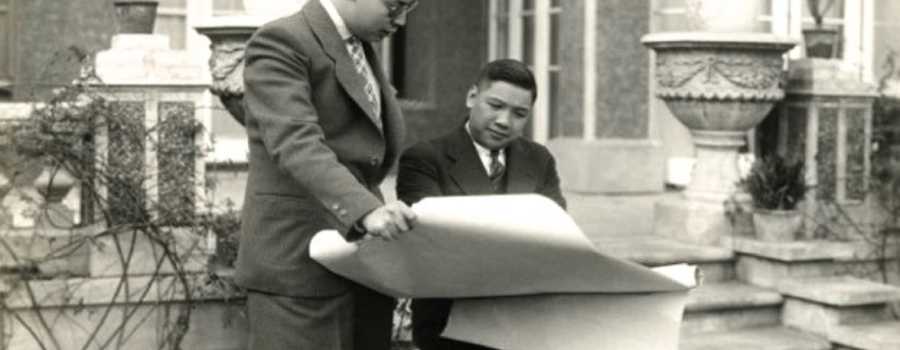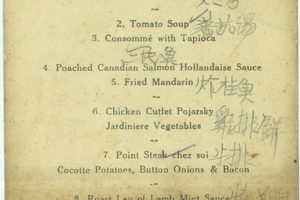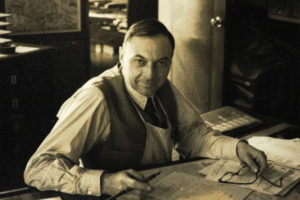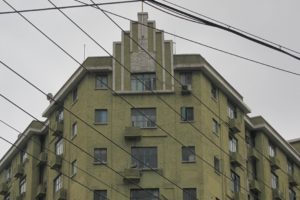China’s first-generation Chinese architects included one American: Poy Gum Lee (李錦沛, Li Jinpei), born to parents from Canton on Mott Street in New York’s Chinatown in 1900, an American citizen by birth. Lee became one of the most important, and versatile, architects in Shanghai, with styles ranging from classic mid-period Art Deco to Mediterranean and Chinese Art Deco.
Chinese Art Deco, a sub-genre that incorporated design elements from classical Chinese culture into the otherwise modern, Western Art Deco style, suited Lee; like him, it was a mix of East and West.

In New York, Lee studied at the Pratt Institute, earning his diploma of architecture in 1920. Pratt served Lee well as he began his career, working for several American architectural firms, where he refined his Modernist design ideas.
Notably, Lee also worked in the Oriental Department of Murphy & Dana’s (later Murphy, McGill & Hamlin) New York office. Principal Henry K. Murphy was a firm advocate of adapting traditional imperial Chinese architecture to modern uses, a style that became increasingly popular as China searched for a national architectural identity. It was a style that appealed to first-generation architects like Lee and others who worked for Murphy, including Robert Fan, Dong Dayou, and Zhao Shen. It also appealed to the Republican government, who hired him as the city planner for their new capital in Nanjing.
Lee was born in the era of the Chinese Exclusion Act, and even with his Pratt training, possibilities for advancement were limited. China, he thought, would have better prospects. In 1923, Lee was hired as the first staff architect for the YMCA (Young Men’s Christian Association) Building Bureau for China, and would spend four years supervising the design and construction of “Y” buildings in 11 cities across the country before launching his own practice.
In Shanghai, the Chinese YMCA and the YWCA (Young Women’s Christian Association) bear his mark, both wonderful showcases of Chinese Art Deco Deco.



The former Chinese YMCA (1934, Robert Fan, Zhao Shen, Poy Gum Lee).
The Chinese YMCA was designed in 1934 with Robert Fan and Zhao Shen, both University of Pennsylvania-trained architects, with Lee in charge of the ornamental and decorative portions. The exterior features a streamlined Western building, topped with a classical Chinese roof, traditional ceramic tiles and all. Like the YWCA, traditional design elements that mesh with the Art Deco aesthetic – geometric, or modernized versions of traditional patterns – are included in the interior.


Interior details, Chinese YMCA by Poy Gum Lee.
The YWCA, erected in 1932, is a different type of Chinese Art Deco: this is a modernist building, one that looks entirely Western from afar. Delicate Ming and Qing-style ornamentation adorn the exterior and inside, Lee uses classical Chinese elements in a riot of color, always keeping with the Art Deco aesthetic, or modernizing the design.


Lauded for his YMCA work, Lee began his own architectural firm in 1927, designing landmark buildings like the breathtaking Woosong Quarantine Station, a streamlined maritine Art Deco building topped with a Chinese tower, the Bank of Canton on Ningbo Road, and the Cantonese Baptist church in Hongkou.



Left: Woosong Quarantine Station; Center: Bank of Canton; Right: Cantonese Baptist Church
One of Lee’s most iconic buildings is not an Art Deco one: the Cosmopolitan Apartments, a Spanish Mediterranean edifice that was, in its day, one of the most luxurious apartments in the city. Owned by Cantonese tycoon Tan Jing, the penthouse featured a ballroom. (The story of the Cosmopolitan through its long-term residents was the subject of a 2009 documentary, Building 173.)


The Cosmopolitan Apartments (left); Poy Gum Lee (seated) with Cosmopolitan owner Tan Jing. Photo of Lee: Lee Family Archives.
Lee’s most famous work, however, is not in Shanghai: it’s the Sun Yat-sen Mausoleum in Nanjing. He was the associate architect to Lu Yanzhi, the architect commissioned to design the Mausoleum. Lee had met Lu through Henry Murphy, and when Lu became ill, and after his death, Lee was entrusted with finishing both the Mausoleum and the Sun Yat-sen Memorial Hall in Guangzhou.


Left: Sun Yat-sen Mausoleum, Nanjing. Right: Poy Gum Lee (left) and Huang Tanfu at the Mausoleum. Photo of Lee: Lee Family Archives
During the Japanese Occupation, Lee taught at St. John’s University, but the writing was on the wall, and in 1945, he returned to New York with his Shanghai-born wife and children. And in New York’s Chinatown today, you can see this Chinese-American architect’s Chinese Art Deco landmarks in America.

This post was originally published on October 8, 2014 and updated on July 10, 2023.
Poy Gum Lee Buildings:
YMCAs in China, 1923-1927
Changsha
Chengdu
Baoding
Chengdu
Fuzhou
Jinan
Nanchang
Nanjing (see Nanjing section)
Ningbo
Shanghai (see Shanghai section)
Xiamen
Shanghai
Frenchtown Shanghai Chinese YMCA
YWCA
Nantao Christian Institute
Mary Farnham Girls School
Cantonese Guild Girls School
Shanghai Quarantine Station
Lingnan School
Cantonese Baptist Church
Cosmopolitan Apartments
Nanjing
Nanjing YMCA
Sun Yat-sen Mausoleum
Capital Cinema
New Capital Cinema
Elsewhere in China
Hangzhou Power Plant, Hangzhou
Central University College of Commerce, Jiangwan
Wuhan University
Quarantine Station, Xiamen
Zhengzhou General Hospital, Zhengzhou







Most Commented Posts